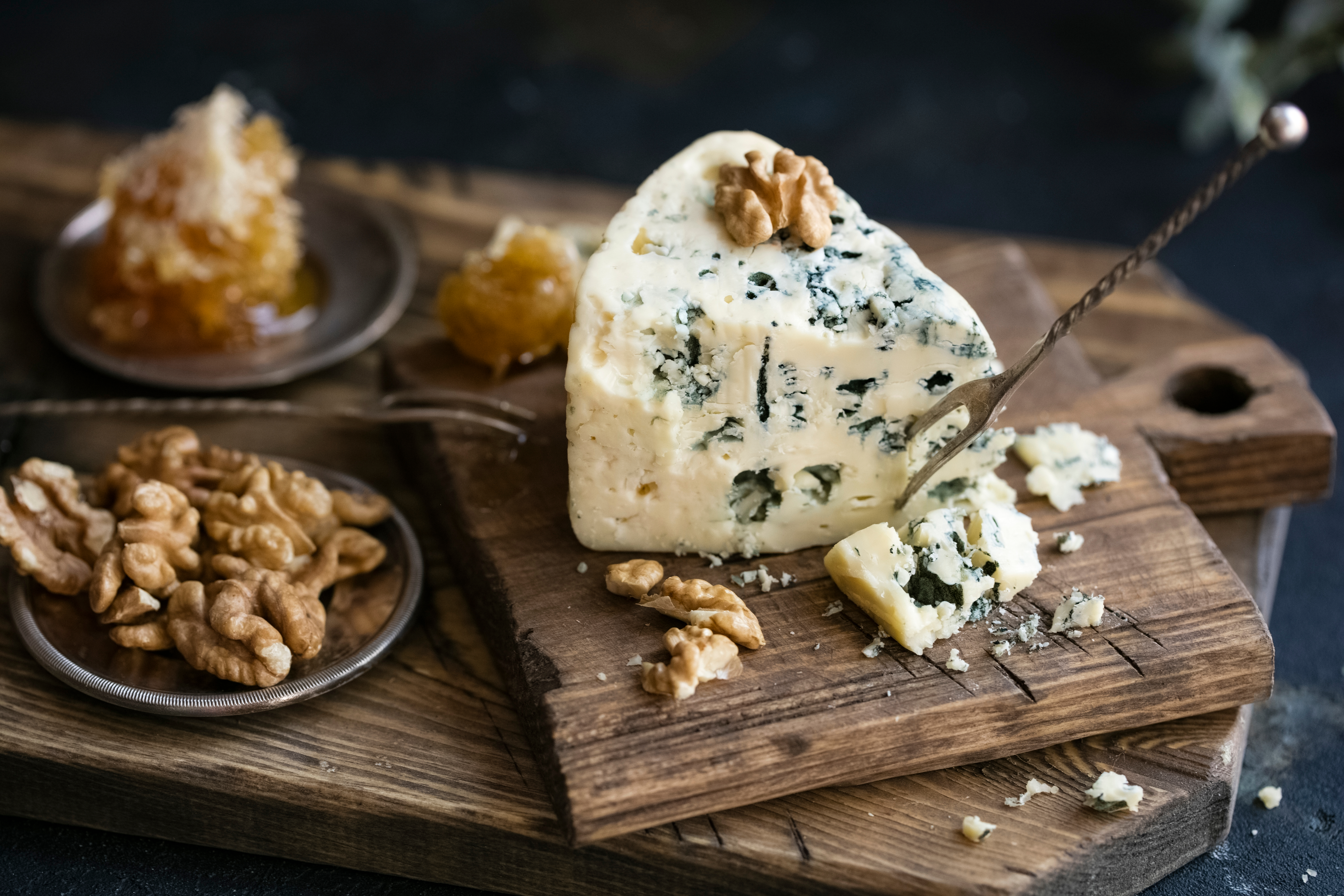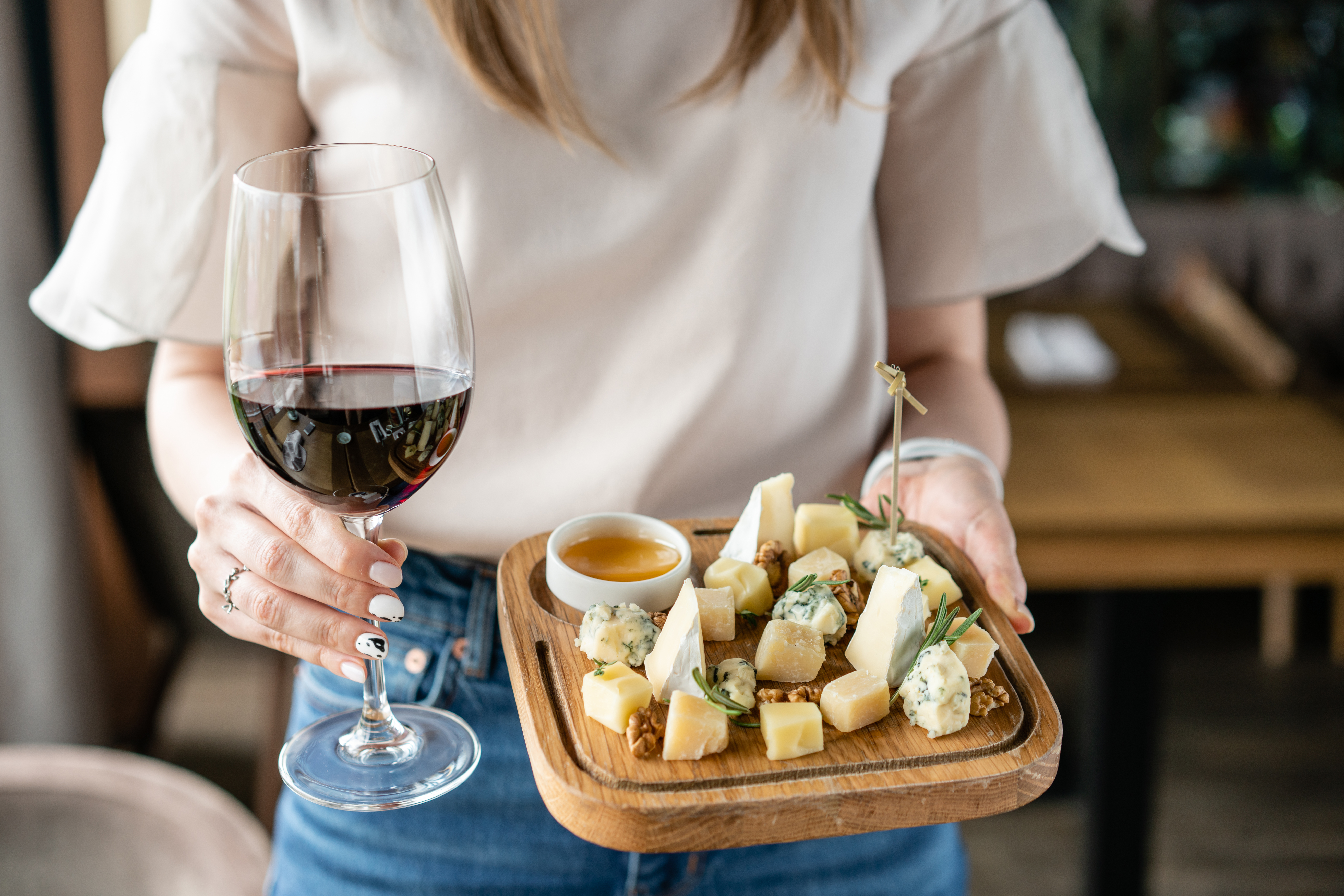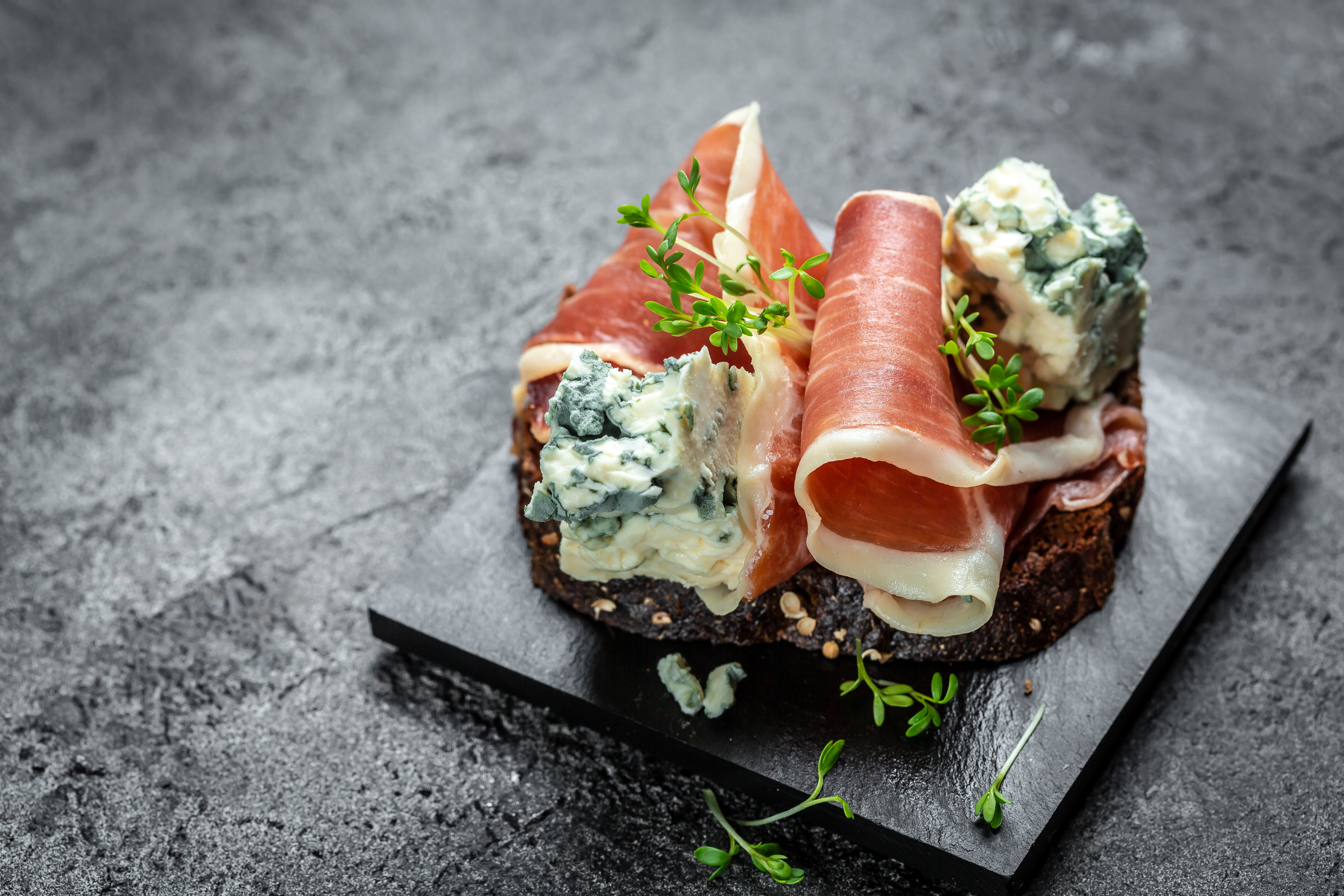Free digital copy
Get Speciality Food magazine delivered to your inbox FREE
Get your free copy
With centuries of history, bucketloads of refined flavour, and legions of fans behind it, it’s no wonder that blue cheese is a stalwart of the independent fine food retailer’s arsenal. A must-buy for consumers across the UK at Christmas and beyond, delicious at the centre of a cheeseboard, paired with a quality tipple (more on that later), and a valuable stocking choice for indies, blue cheese has become one of the most iconic tastes of Britain across the world.
While food lovers of all persuasions appreciate a great blue, this pillar of British cuisine is still at risk due to a steady loss in volume sales. “If this trend continues, even at a slowed rate, we could be looking at a significant decline which is a huge challenge,” says Bill Mathieson, managing director of Long Clawson Dairy. “The result could not only be a loss of a fabulous British cheese with so much history, but also the loss of some traditional Stilton dairies.”
A delicious, versatile and punch-packing cheese counter classic in need of a sales boost? Sounds like a job for Speciality Food readers!
As with many speciality products, blue cheese can often divide opinion but turn heads with considered education. “Blue cheese is a journey, not a destination,” states Vickie Rogerson, co-founder of Homage2Fromage and MD of North PR, “so do all you can to guide customers along the path with a range of delicious options. It is a bit like Marmite. You either love it or you hate it. However, I think it’s a much-misunderstood cheese type and just like dating, you need to try a few before you find your perfect partner.”
Thankfully, there are plenty of options to choose from. “Blue cheese comes in many different forms, some like Roquefort are so spicy that the blue can make your teeth hum, but there are other milder creamier ones like Montagnolo Affine which are mild and voluptuous,” she says. “Stilton is the classic British Christmas cheeseboard blue and there are many excellent ones but it’s not for everyone. I prefer softer, creamier, unctuous blues that have a suggestion of spice without the full-on blue that punches you in the mouth.”
Blue cheese may pack a punch, but your customers shouldn’t be afraid to experiment with it in their kitchens – nor should you in your café and deli counter menus. Vickie suggests keeping an eye on social media to stay up-to-date with what is whetting the appetite of shoppers. “TikTok is the birthplace of some rather unusual food trends but there are some real gems. There’s currently a trend for #bringaboardnights which are themed grazing boards piled high with anything you like including chocolate, cheese, charcuterie, vegetables, pickles, condiments etc,” she says. “It’s a great way to present lots of chunks of cheese and blues really stand out. Waxed portions of cheese work really well for this, so try and have a balance of some waxed Stilton, some unusual enhanced cheeses, and even a Grand Noir Wedge, which is a softer blue from Germany.”
For Jason Christie, chef at The Crown at Church Enstone, blue cheese is a valuable ingredient in his culinary toolbox. “Blue cheese has a remarkable ability to add umami-packed richness to a dish.” he begins. “The action of the enzymes from the milk, microbes and rennet on concentrated proteins and fat leads to many flavour compounds being developed. This translates into a full, rich savouriness on the palate.
“Blue cheese is not just blue cheese, you have buttery, fruity and almost sweet blues like Stilton, Bleu d’Auvergne and Gorgonzola that tend to be milder and can be used for certain applications, and Roquefort with more peppery notes can be used for others. Understanding the differences between them helps in creating a well-balanced full flavoured dish.”
Roquefort and steak, Stilton or Bleu d’Auvergne with beetroot and fig… finding the perfect pairing makes a real difference to the final dish, says Jason, and there’s no need to stick to the traditional – a left-field option can be surprisingly delicious. “One of my fondest food memories is the time I first had Gorgonzola ice cream. It came with a pear sorbet in a gelatoria in Italy and it was simply a revelation. Although this might sound disgusting, this is not one of those faddy things that sounds interesting but actually tastes awful - it’s one of the most delicious things you will ever eat. Because of its rich umami flavours, it creates a savouriness that you must keep going back for. The closest thing I can liken it to is salted caramel ice cream.”
Whether you choose to keep it classic or go out on a limb with your blue cheese pairings throughout the year, blue cheese will be a favourite come Christmastime. “There is not much greater than sitting in front of a roaring fire, after the sun has set on all the present giving and roast turkey, with a salty and creamy blue cheese balanced by a sweet ruby port,” says Jason. “I can imagine whole truckles of blue soaking up the contents of a bottle of port come Christmas Day evening.”

When it comes to selling blues, “sampling is absolutely key, and that’s even more important at Christmas when everyone is looking for cheese,” says Vickie. “We present all our cheeses at our Homage2Fromage cheese nights blind, so people aren’t prejudiced before they’ve tried it. You’d be amazed what you actually like when you don’t know what it is!
“Showing off a range of different types of blue from hard to soft and everything in between is a brilliant way to coax people into the world of blue cheese,” she continues. “Showcasing classic British blues like Colston Basset Stilton is a must, but don’t forget those slightly more unusual blues. I find Shepherd’s Purse Bluemin White really intriguing. It presents like a little Brie but has flecks of blue shooting through it. Well worth having on your cheese counters. And don’t get me started on Feltham’s Farm Renegade Monk, which won Supreme Champion at the 2020 Virtual Cheese Awards! It’s a crazy mash-up of soft white, rind washed and blue cheese. Amazing!”
A great cheese counter offers a curated range of excellent blues to tempt customers’ taste buds, and – luckily for fine food indies – the UK is home to some of the very best. Oxford Cheese’s two blues are modern additions to Britain’s blue cheese portfolio. Created by Baron Pouget in 1995, Oxford Blue is a semi-soft and smooth English blue and a natural rival to Continental options such as Cambozola, Dolcelatte and Fourme d’Ambert whilst showcasing the savoury complexity of an English Stilton.
Oxford Blue’s newer stablemate, Oxford Dolce, shares some similarities with Gorgonzola Dolce – creamy and slightly sweet, it is matured for a minimum of 14 weeks. “For some time we worked on developing a new blue cheese to sell alongside our Oxford Blue,” says Robert Pouget. “Oxford Blue has a very English flavour in the style of a soft Stilton, but I wanted something sweeter, more akin to Gorgonzola. We worked on creating our new cheese and when we thought we had it about right we called it Oxford Dolce.”
When it comes to wine pairing it always comes down to personal choice. “Personally,” Robert continues, “I would always choose a full bodied red, such as a good Burgundy or red Rioja. I’m a man whose long experience has taught me that with cheese you can’t beat a good red!”
Meanwhile, a cheesemaker putting heritage front and centre of its portfolio is Long Clawson Dairy, originally set up by 12 neighbouring farmers as a farmer-owned co-operative in 1912 and now launching 1912 Artisan Blue Stilton – the latest release in its range of award-winning cheeses. “In terms of food trends, Stilton has always been known as the King of English Cheeses, but while Stilton is a much-loved cheese, it’s not celebrated as much as it might be given that it really is the Champagne of English cheese,” says Bill.
This passion is now proudly shared by legendary chef Marco Pierre White, who is the ambassador for 1912 and will be featuring the cheese in his restaurants and pubs, as well as developing a range of delicious recipes showcasing 1912 for food lovers to enjoy at home. This new cheese is certainly worthy of such a high-level spokesperson; “We believe it to be a Stilton like no other,” says Bill, “as it is made with the craft and care of our master cheesemakers, with over 200 years of collective experience, and goes through a triple check process with our affineurs to ensure only the highest quality cheese.”
Another modern icon of blue cheese is Shepherds Purse, a family-run trailblazing cheesemaker from North Yorkshire which has a number of blues in its range. From the award-winning cow’s milk Yorkshire Blue, renowned for its mild creaminess which makes way to rich complexity, to Buffalo Blue, a buffalo milk cheese; Bluemin White, a soft cheese with a velvety blue rind which ripens from the outside in; Harrogate Blue, an award-winner from two weeks post-launch; and Northern Blue, a robust cheese likened to a punchier Yorkshire Blue. Resolutely independent and loved by consumers who appreciate a great blue cheese, this is a range well worth an investment of counter space.

These three unusual blue cheeses offer a captivating journey for your taste buds and are sure to elevate your customers’ cheese-tasting experience. So, venture off the beaten path and savour the world of blue cheeses in all its delightful diversity. Your cheeseboard will thank you for it!
1. Biggar Blue - Scotland’s hidden gem
Scotland may not be the first place that comes to mind when you think of blue cheese, but Biggar Blue is here to change that perception. Produced by Errington Cheese Ltd., one of Britain’s top farmhouse cheesemakers, Biggar Blue is a raw goats’ milk cheese made using the Roquefort recipe. What sets it apart is its moderate creaminess and a delightful bite that gives way to a symphony of flavours. Behind the initial salty notes, you will discover hints of nutty sweetness and a satisfying richness. This cheese pairs wonderfully with red wines or a robust stout, making it a unique addition to any cheeseboard.
2. La Peral - a Spanish artisan delight
From the remote region of Asturias in northern Spain comes La Peral, a creamy and artisan blue cheese with a moderate bite and exceptional complexity. Crafted at a family dairy using time-honoured methods, La Peral is matured for two to five months, allowing its flavours to develop into a rich, creamy and distinct profile. With age, it can even become delightfully wild in flavour. To complement the cheese’s nuances, pair it with port wine or similar sweet wines. La Peral is a true testament to the skill and tradition of Spanish cheesemakers.
3. Gorgonzola Piccante - the original Gorgonzola
Before the world fell in love with Gorgonzola Dolce, there was Gorgonzola Piccante. This cheese, also known as naturale, di monte, stagionato, or simply mountain Gorgonzola, is the older sibling that packs a punch. Firmer and much stronger in flavour than its sweeter counterpart, Gorgonzola Piccante boasts lingering nutty notes. What sets it apart is its unique cave-aging process, where it is repeatedly washed with a brine for a year or more. This treatment results in a pronounced aroma, a sticky rind, and a bold bite. For a perfect pairing, reach for full-bodied red wines, red-grape-based dessert wines, or more unusual sweet drinks, like our Melina Honey Wine.

Blue cheese is one of the most polarising of the vast world of cheeses. From sheer delight to a wary hesitance, blue cheese certainly never fails to leave an impression.
Sourcing: When it comes to sourcing blue cheeses, my focus has always been on artisanal varieties. The beauty of artisan cheese is the care, tradition, and expertise that is imbued in every wheel. These cheeses are often handmade using traditional methods and in smaller batches, which can result in more distinct and nuanced flavours. For a blue cheese to truly shine, it must come from a producer who understands the delicate balance between the mould and the milk.
Storing: Storing blue cheese is a delicate affair. To maintain its character without letting it overpower or, worse, be overpowered, the ideal temperature is below 8°C in the fridge. I recommend placing the cheese in a Tupperware, delicately wrapped in clingfilm or the wax paper they arrived in. The addition of a paper towel is essential as it helps absorb any excess moisture, maintaining the cheese’s desired consistency. And of course, due to its eager mould cultures, it’s always a good idea to store blue cheese away from other varieties to prevent cross-contamination.
Selling and tasting: Engaging with customers about blue cheese is always an interesting experience! Many approach it with apprehension, thanks to its mouldy look and pungent smell. However, I believe that there is a blue cheese for everyone. At my tasting events, I often encounter individuals who are convinced they aren’t fans. Yet, with the spectrum ranging from sweet and creamy to spicy and crumbly, many find themselves enamoured by the end of a session, especially when paired with wines. I have always been fond of Tosi Gorgonzola for its decadent creamy texture and mild spicy notes. Beauvale offers a soft, luxurious mouthfeel that contrasts with its pronounced blue tang. Colston Bassett Stilton, on the other hand, is a classic with a rich history, known for its velvety texture and robust flavour.
Port and blue cheese go hand in hand. Its robust intensity and sweetness marries well with the bold flavours of blue cheese. Vintage Port, full-bodied and powerful, with well-integrated tannins, is a classic partner for Stilton and other strong blue cheeses, eg Gorgonzola, Roquefort, bringing depth and sweetness to harmonise with the piquant tangy notes of the cheese, while more mellow aged Tawnies have subtle notes of nuts and wood which help bring out the blue cheese’s complexity.
The rich fragrant aromas, mellow fruit and hints of honey (and sometimes oak) that you can find in a lightly chilled white Port would complement harder blue cheese. Cabrales, a Spanish cow’s milk cheese, served with some nuts, and dried fruits would work well and bring out the mellow nutty notes in the cheese.
Sharper, salty and creamy blue cheeses such as Roquefort are also great paired with fortified sweet wines such as a Maury Vin Doux Naturel from the South of France. Gorgonzola is another good option. Its creamy texture and tangy, earthy flavours can provide a nice counterpoint to the sweetness of the wine. Milder options include Cashel Blue and Fourme d’Ambert, both buttery and delicate - these are both good choices for sweeter wines as opposed to Ports.
Don’t overlook white wine! A dry white with good acidity can work well with creamy, soft rind cheeses, the acidity cutting through the creaminess. Equally, bolder, creamier textured whites such as oaked Chardonnay or barrel-aged riper styles of white wines can be an awesome combination for dishes with blue cheese sauces. Try with Quinta da Pedra Alta Reserva Branco 2020 or Domaine Jones Jones Perle Rare Blanc NV.